We're back with the second list of 30 days of diverse picture books! Like the previous list of diverse books for preschoolers, this list is designed to give you and your children an entire month's worth of reading in one list. Although I have labeled this a list diverse books for kindergarten and first grade, the age recommendation is not strict! Certainly any of the books on the previous list will also be enjoyed by kindergarteners and first graders, and older children will enjoy these diverse and multicultural picture books as well!
These books reflect a diversity of experiences and multicultural families. The list is divided into six weeks of five books each, to make it easy for teachers and other caregivers, but parents may choose to read a book each day for a month. Of course, you can mix or match as you see fit. No prescriptions! Happy reading. (Note: book covers and titles are affiliate links.)
More:
30 days of diverse books for 2nd and 3rd grade
WEEK ONE
Today by Julie Morstad. I love this extra large book with its myriad of illustrations. It begins with a girl waking up and the text asking "What should I do today?" Every decision, from choosing a hairdo to choosing a snack to reading a book to picking transportation offers an array of diverse options, each one illustrated and labeled. The book is filled with children of all backgrounds and kids will love discussing how they would chose to spend their day!
Confetti: Poems for Children by Pat Mora, illustrated by Enrique O. Sanchez. This is a joyful collection of short poems sprinkled with Spanish words. Pat Mora has done a wonderful job composing poems that will appeal to very young children on a range of subjects like colors, nature, counting and everyday moments.
Hello Goodbye Dog by Maria Gianferrari, illustrated by Patrice Barton. Zara has a dog named Moose. Moose loves Zara so much he wants to go with her everywhere. Moose is not a service dog, but others see his potential as a good companion and Moose goes through the training to become a therapy dog. Although Zara is in a wheelchair, the story isn't about her physical challenges, it is about the joy of friendship with a furry friend.
Thunder Boy Jr. by Sherman Alexie is both fun and thought-provoking. Thunder Boy, Jr. wishes he had a normal name, like his sister. And he does not like being called "Little Thunder," which sounds "like a burp or a fart." He sets out to pick a new name, perhaps one that reflects one of his great achievements. In the end, he settles on a the perfect name—one that is both his very own and still connects him to his dad.
Yo Soy Muslim by Mark Gonzales, illustrated by Mehrdokht Amini. The narrative is written as a letter from a father to his daughter, but it reads like a poem. The father recognizes that his child will have questions about who she is and what she can accomplish. Celebrating their shared faith and culture and language, the father's letter aims to give his daughter confidence and pride in her identity as a Latina and as a Muslim.
WEEK TWO
This Is How We Do It by Matt Lamothe. The book follows seven children from different countries: Italy, Japan, Uganda, Russia, India, Peru and Iran. Each contemporary child describes their home, school, family, food and daily life. This is a great starting point for conversations about the differences and similarities between life in different countries, but also how children in the same country don't all live the same way. At the end, photographs reveal the actual families depicted in in the book. I love the large size of the book, and how the illustrations invite a lengthly perusal.
Cora Cooks Pancit by Dorina K. Lazo Gilmore, illustrated by Kristi Valiant. Confession: I have a soft spot for picture books that show families cooking. I don't know why, since cooking is not really my thing. Cora's favorite Filipino dish is pancit, a noodle and chicken meal. One day, when her older siblings head out to the mall, Cora jumps at the chance to help Mama make the delicious dish. During the food preparation, Cora learns about the family's history and Filipino culture.
Marisol McDonald Doesn't Match / Marisol McDonald no combina by Monica Brown, illustrated by Sara Palacios. Red-headed half-Scottish half-Peruvian Marisol bounces off the page with great enthusiasm and loves her mismatched life. When her friend, Ollie, challenges her to “match,” Marisol finds she is unhappy with life as a conformist. This is a great story that emphasizes the importance of embracing and accepting one’s uniqueness. A bilingual book.
Stella Brings the Family by Miriam B. Schiffer. Stella doesn't feel different than the other kids, but she realizes her parents are different from a lot of the other families she knows. Her school class is planning a Mother's Day celebration, so Stella comes up with a way to include her two dads. The lovely way the book communicates that Stella's dads can do all the things a mom can do sends a positive message that families may look different, but the love is the same.
More-igami by Dori Kleber, illustrated by G. Brian Karas. This is a sweet story of perseverance. After his classmate's mother teaches him origami, Joey is determined to be a master folder. But it takes lots of practice! He finds the perfect place to hone his skills at the local restaurant. I loved how Joey spent time folding everything he could get his hands on, including the money!
WEEK THREE
All the Way to Havana by Margarita Engle, illustrated by Mike Curato. I loved the rhythm of this book! A boy and his family drive to Havana in their car, Cara-Cara. Along the way, the boy takes in all the sights and sounds of the drive, especially the sounds made by his beloved car. The illustrations are wonderfully vibrant. This is a great read aloud choice.
A Hat for Mrs. Goldman: A Story About Knitting and Love by Michelle Edwards, illustrated by G. Brian Karas. This is such and incredibly sweet and inspiring story! Mrs. Goldman, a Jewish woman, makes hats for others, performing a mitzvah. Her Latina neighbor Sophie likes to help her by making the pom poms that top each one. When winter arrives Sophie notices that Mrs. Goldman doesn't have a hat of her own and although knitting is challenging for Sophie, she sets about making a hat for her friend. When she is done with the hat, her lack of knitting skills means the hat has a few holes. However, since Sophie knows Mrs. Goldman loves her pom poms, Sophie covers up the holes in a creative way. Mrs. Goldman, of course, loves the hat and the kindness shown to her.
The Name Jar by Yangsook Choi. Unhei has just moved to America from Korea. She loves her name but when the other kids can't pronounce it, she worries about fitting in. She decides she should choose a new American name. Her classmates fill up a jar with potential new names but with the support of others Unhei decides she wants to keep her Korean name. This book is so important, especially in classrooms in which children may have names that are difficult for English speakers to say. Names are a big part of a person's identity and we serve children well by valuing them.
Back to Front and Upside Down by Claire Alexander. The class is making cards for their principal but Stan has trouble forming letters and his handwriting is all mushy and unreadable. He feels discouraged but doesn't know how to ask for help. Many parents have children who struggle greatly with handwriting and this sweet book emphasizes the importance of getting help for one's struggles and giving oneself permission to take the time necessary to learn and accomplish one's tasks.
Maybe Something Beautiful by F. Isabel Campoy and Theresa Howell, illustrated by Rafael López. This book is based on a true story. Mira and her neighbors transform their environment with colorful murals. I love the vibrant illustrations and the message that art makes life better!
WEEK FOUR
The Water Princess by Susan Verde, and Georgie Badiel, illustrated by Peter H. Reynolds. I loved this book when I read it and I was surprised I didn't already have it on a list! In an African community, water is precious and every day Gie Gie and the other girls must travel far in order to fetch clear drinking water for the community. Gie Gie can command other forces of nature: she tames the dogs, she plays hide and seek with the wind, but she can't seem to make the water safe to drink. But she perseveres and never gives up hope that one day she will have enough clean, clear water.
Lucia the Luchadora by Cynthia Leonor Garza, illustrated by Alyssa Bermudez. This is a fun, exuberant book, which you can pair with Niño Wrestles the World (on the 30 days of diverse preschool books list). Lucia runs through the playground with her red cape, and the boys tell her "girls can't be superheroes." This makes Lucia mad, "Spicy mad. KA-POW kind of mad." Then, her grandmother tells her about the luchadoras and together they hatch a marvelous plan.
I'm New Here by Anne Sibley O'Brien. Every child knows what it is like to walk into a room and not know anyone. Compound that with not being able to speak the language, or not being familiar with the culture and it can lead to some anxiety indeed. Three children—from Guatemala, Korea, and Somalia—tell their stories of what it is like to be the new kid from a distant land.
Monsoon by Uma Krishnaswami, illustrated by Jamel Akib. I love this book about a girl describing how her family waits for the monsoon rains. The land is dry and they wonder if the rain will every come. The illustrations are full of life and the poetic text is fun to read aloud.
That Is My Dream! by Langston Hughes, illustrated by Daniel Miyares. This is a picture book of Hughes's poem, "Dream Variation," about the dream of living without racial prejudice. Each page spread contains a short line of the poem, accompanied by brilliant illustrations. In the illustrations we see the dream of transformation from a segregated community to one in which a white child and an African-American child can splash their faces with water from the same pond. A gorgeous book and excellent introduction for children to Hughes's splendid poetry.
WEEK FIVE
The Rain Stomper by Boswell Addie, illustrated by Eric Velasquez. I love the joyful spirit of this book, the illustrations are alive with movement. Jazmin is excited to twirl her baton in a parade, but the rain threatens to spoil everything. At first she takes out her anger by stomping in the puddles, but that energy quickly turns into something else as she spins and jumps, twirls and splashes. The rest of the neighborhood can't help but be drawn in. This is an engaging book showing how the physical release of emotion can lead to positive action and release.
A Morning with Grandpa by Sylvia Liu, illustrated by Christina Forshay. Mindfulness doesn't have to take place in solitude! I adore this book about how a girl connects with her grandfather over the practice of Tai Chi. Mei Mei joins her grandpa in the morning for his daily ritual but while he is smooth and graceful, Mei Mei puts her own spin on things, reminding us that mindfulness need not always be practiced in the stillness. A wonderful story.
Where's Rodney? by Carmen Bogan, illustrated by Floyd Cooper. This is a really fun story about a boy who can't sit still (we all know kids like that, right?) and just wants to be outside! Cooper's illustrations marvelously capture Rodney's energy as he discovers the joys of being in a park and all the ways he can finally express himself and release his energy!
A Full Moon Is Rising by Marilyn Singer, illustrated by Julia Cairns. A collection of poems that celebrate the magic of a full moon as it is experienced around the globe. There are poems set it the city, the country and across the world from Africa to China to Colombia. Different religious and ethnic traditions are represented, including Sukkot, moon watching in Canada and the Chinese Moon Festival. This is truly a multicultural collection. The end papers include notes and a map of all the locations that appear throughout the book.
Jalapeño Bagels. Pablo needs to bring in something to school for International Day. He debates whether or not to bring in his mother's delicious Mexican baked goods or his father's challah. From the title you can guess his decision! This book is sure to make you hungry so have a snack handy. Includes a Yiddish and Spanish glossary.
WEEK SIX
Last Stop On Market Street by Matt de la Peña, illustrated by Christian Robinson. I wasn't going to put this book on the list because I prefer to make room for new-to-you books and this one is so popular. But then I caved. So even if you've read it, add it in to your reading list again. A boy and his grandma catch the bus. We don't yet know where they are headed, but along the way the boy asks questions about why they don't have certain luxuries. The grandma has a ready answer about the advantages of what they do have and encourages him to think of positive aspects of lacking material goods. When they reach their destination we find out that they were traveling to help out at a soup kitchen.
Alfie (The Turtle that Disappeared) by Thyra Heder. This may be the only book in which the narration is told first from a human point of view, and then from a turtle's. Nia got a turtle for her birthday, but turtles don't really do much, when it comes right down to it. So Nia doesn't pay much attention to Alfie, until he disappears. Alfie narrates what happened to him while he was missing (one whole year!). It turns out he was searching for the perfect present for Nia. Absolutely adorable.
Just a Minute: A Trickster Tale and Counting Book by Yuyi Morales. I adore trickster tales and this one about a grandmother who outsmarts a skeleton is quite a treat. A skeleton comes to fetch Grandma Beetle on her birthday, but the clever woman thwarts him as she claims to have too many chores to do first. The tale seamlessly weaves Spanish language numbers into the humorous narrative as grandma counts up the tasks she must do in order to keep the skeleton at bay.
The Children's Garden: Growing Food in the City by Carole Lexa Schaefer, illustrated by Pierr Morgan. I love books which celebrate how urban communities come together, with all their diversity, and transform their neighborhoods for the better. In this one, the neighborhood children learn about agriculture and sustainability while they grow food in a community garden.
Rulers of the Playground by Joseph Kuefler. On the playground, Jonah declares himself the ruler. At first, the others play along, although with some eye-rolling. But soon, Jonah has a challenger who wants to be the ruler herself and the two engage in some spirited political battles! The wonderful illustrations depict the life of the playground with all it's actions, both large and small. It is teeming with a diverse group of children who eventually give up on both the would-be tyrants and forge a peace, instead. I particularly liked the droll ending.
Sad that your 30 days of diverse books for kindergarteners and first graders is over? Try the books on these lists:
- Picture books with multicultural families
- Read folktales from around the world
- 50 picture books to take you on a trip around the world


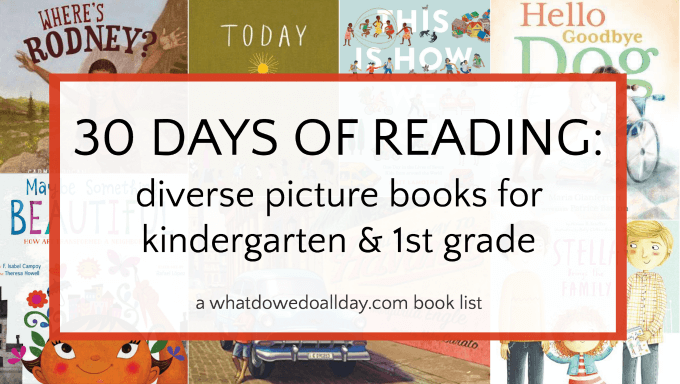

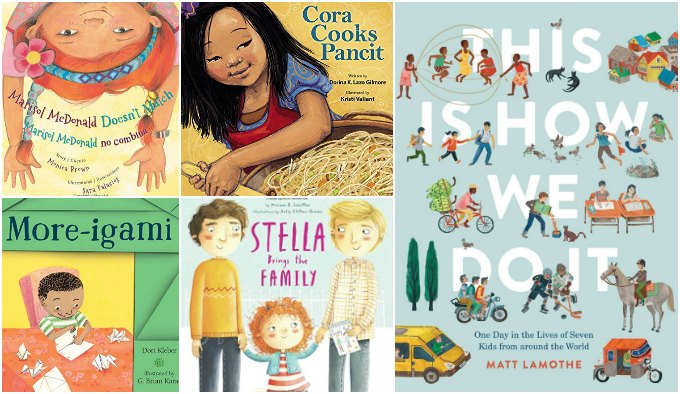


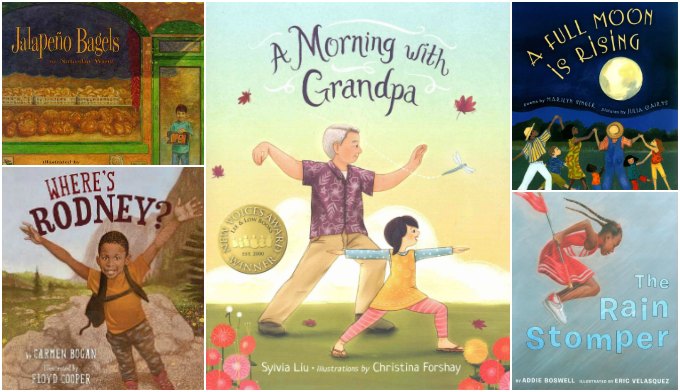
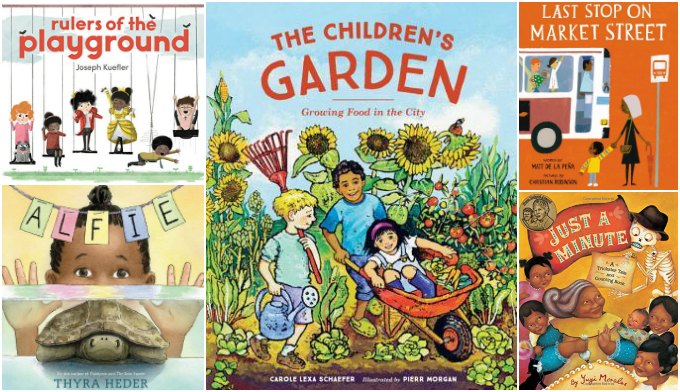
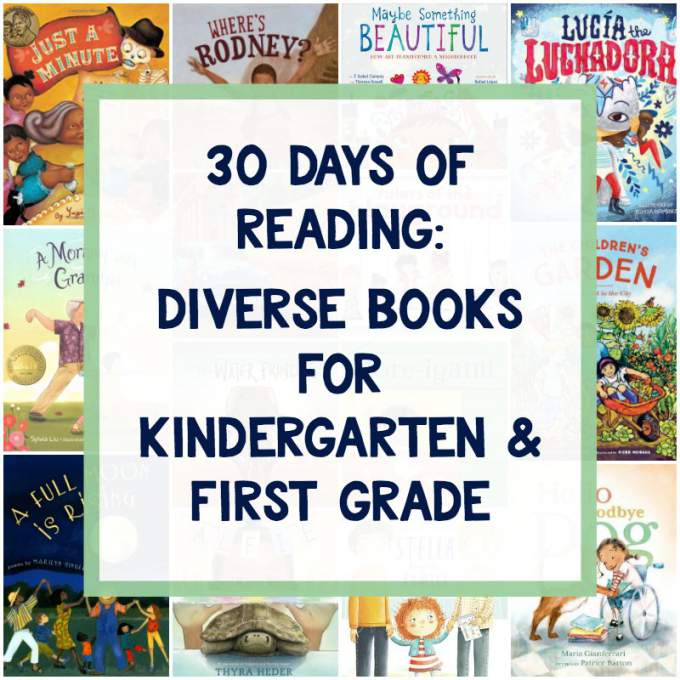
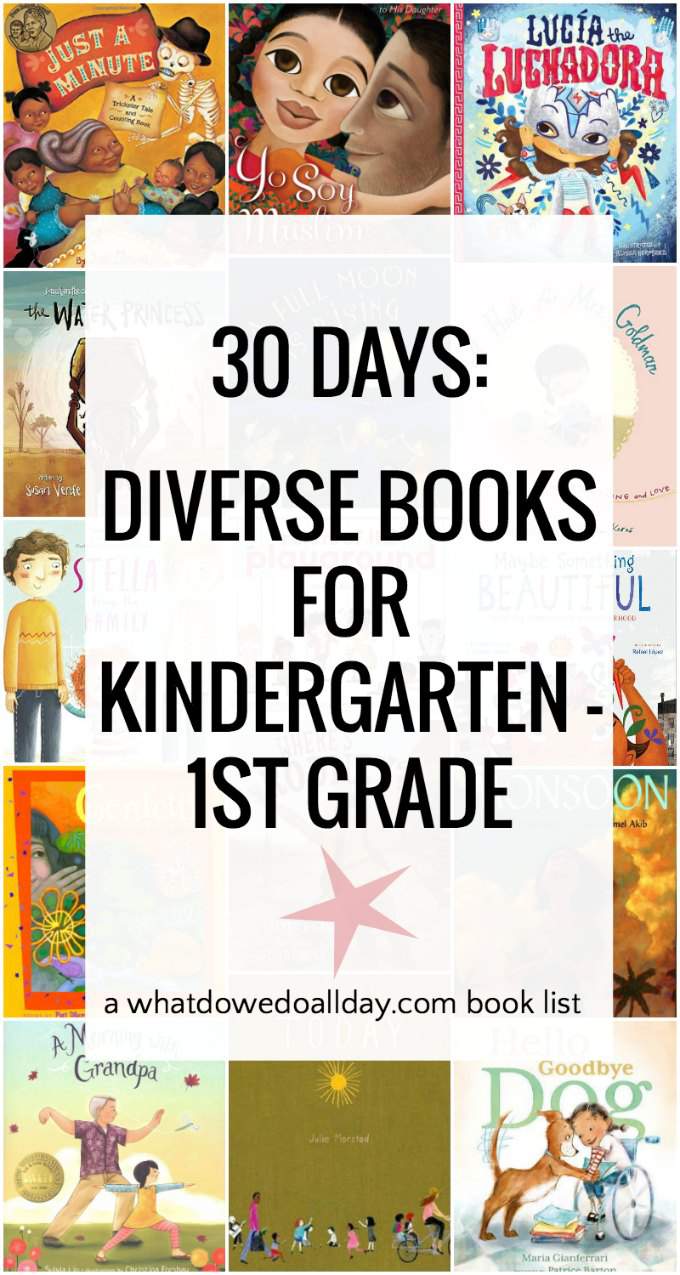

Nwajagu Phil says
Awesome job you are doing here Erica. i am a mother of a 5 years old , we live in Nigeria,somewhere in Africa. please is there a way i can get the Pdf of theses books? would really love my daughter to have an excellent reading routine